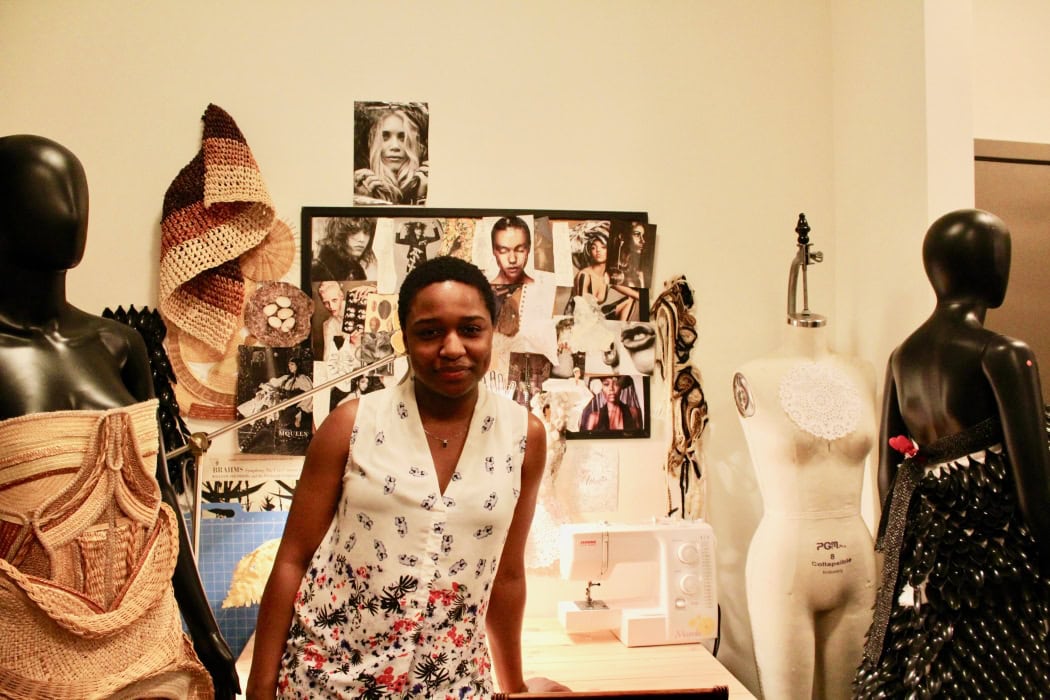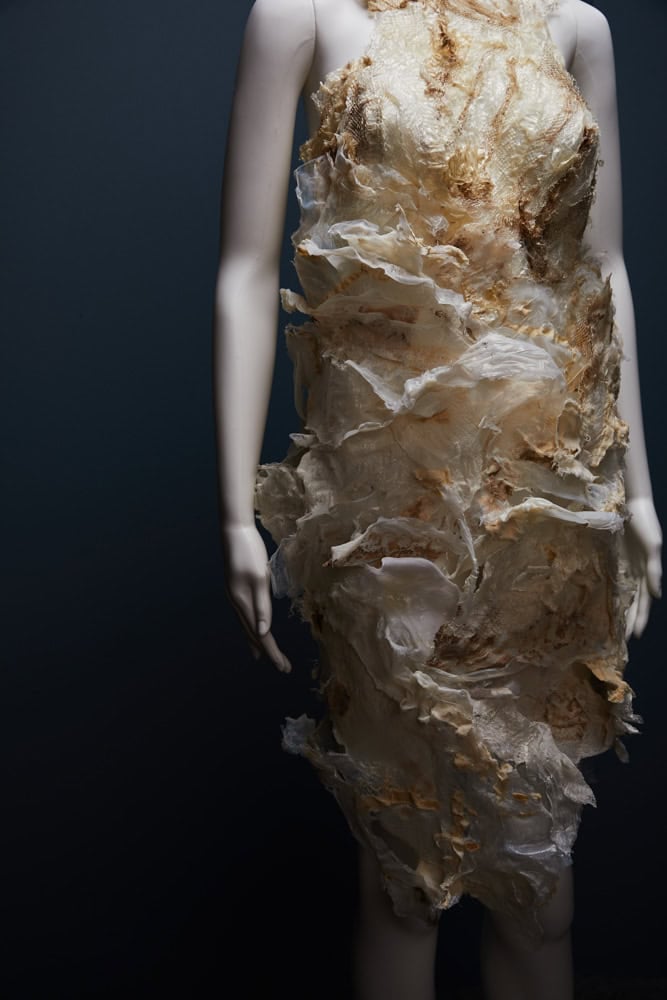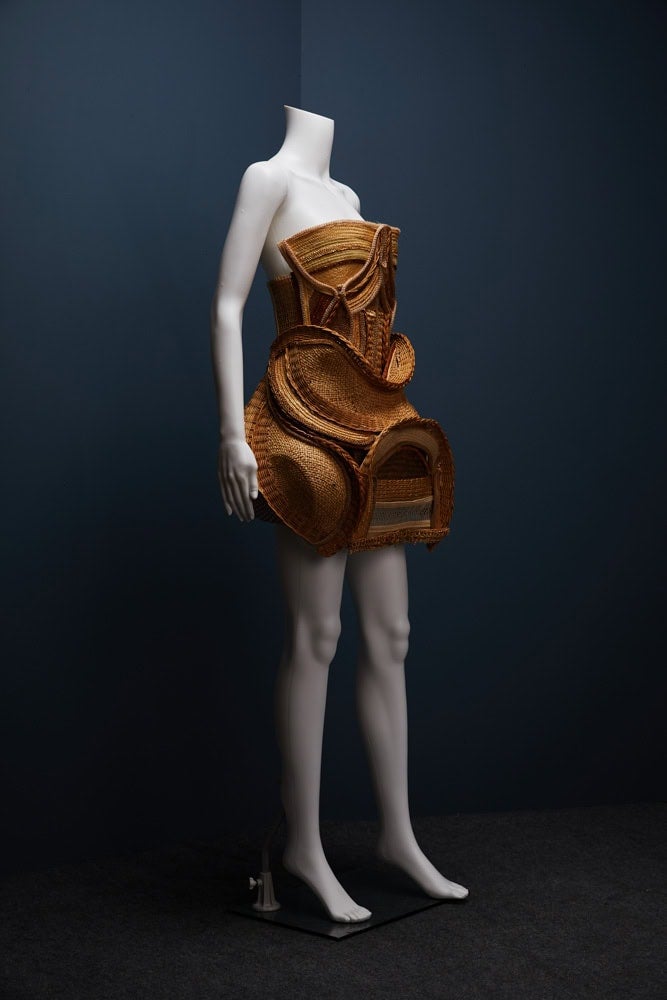
Charity Harris is a self-proclaimed social sculptor and recipient of a 2017 Idea Capital Grant. The Atlanta-based artist creates women’s fashion out of recognizable materials such as plastic spoons, shower curtains, acorns, and synthetic hair in an effort to discuss the South’s difficult history with nature, race, gender and religion. After earning her B.A, at Georgia State, Harris has focused on expanding her practice as both a student of fashion and the fiber arts. I sat down with her earlier this month to discuss her process and how being a Southerner has informed her work, and to get a peek at works that will be in a forthcoming exhibition at Hathaway Gallery.
Alison Lechner: You call yourself a “social sculptor.” Can you unpack that for me? What does that mean to you, as opposed to just a fashion designer or a sculptor?
Charity Harris: All of my sculptures are based on sticky subjects like race and gender, and how as a society we deal with them and how I personally deal with them. I think taking that on in a piece of clothing is a little presumptuous. I look at it as a sculpture that’s not necessarily meant to be worn but to function as a kind of third body.
I got the idea of social sculpture or even just social art from Josef Beuys, and this idea that art has the potential to change the world or at the very least have some effect on it. I will not say that my art has changed the world, but the biggest contribution that these pieces have is to start the conversation. A lot of the pieces focus on one particular subject or something that I think is of the time we are living in, and from there I work through that and determine what materials get that point across best.

The sculpture with the white braided hair, in particular, is about cultural appropriation. With this dress, I was determined to find the whitest or blondest weave that I could possibly find, almost like a Kardashian-blonde. It was also a piece that had a kind of experimental quality for me. I grew up getting my hair braided every summer, and to take something personal to me, like hair-braiding and making these braids as blonde as possible, and to think about the fact that most white people do not get their hair braided, and that’s just because the texture of your hair would slip out. Just on a feasibility level, it just doesn’t make any sense. That was just such a huge thing for me, growing up. Every single summer, rain or shine, getting my hair braided. My mom was not having it — if you were going to the pool, you were getting your hair braided because ‘I’m not doing your hair every day.’ And to look at that as a fond memory, and so I try to take that kind of personal experience and then mesh it with something that we are dealing with now.
I think that’s part of why we are in such a flux of cultural appropriation. Is that really your experience? Or are you just taking it for your own because you think that it’s cool at the time? I don’t think that it’s a problem to take different ideas to find your style. I just think you need to be responsible.
AL: It’s so funny that you brought that up regarding that dress, because that dress is super blonde and so in-your-face that almost as if you are providing a response in the Kardashians’ absence, as they often do not acknowledge that they are appropriating. Another thing that I instantly thought of with that dress is that it is very structural and very intricately patterned, and I think of how that Kardashians often promote the Balmain brand, a brand that has a very structural, intricate, pattern-heavy aesthetic. I love the connections that you are making with that dress and it’s clear it was a very specific design for that purpose.
CH: It’s funny that you say they are structural, because once I started making them I realized that they are very texture-heavy, and even just heavy in general. That was something that really surprised me as I started making them, that they started to become like armor. Some of them do not bend or flex at all, with just the amount of material that is on them, they just don’t move. Dealing with the subjects that I choose to deal with, these really sticky subjects that no one wants to talk about, I feel like we put up our own kind of armor to protect ourselves in taking on these subjects. It’s like they are taking on the weight of these subjects themselves. That was something that I only realized as I was creating these and trying to understand that they become heavy just by the amount of material that I use. And that was not on purpose but it worked.

AL: It provides the materiality and textuality to these ideas you’re trying to evoke with these pieces.
CH: It was a beautiful happenstance that provided a nice little cherry on top.
AL: Now let’s back up a bit and talk about how you began making these pieces with unusual materials?
CH: When I was at GSU, I was I was attempting to make projects with materials that were cheap. I was broke, so it was born out of necessity. I think my first piece was made out of construction rope, braided hair, wire, and some fabric that I had dyed in textiles class. I made it into a piece I called Sister Robe, and it was in the form of a church robe, and the big construction rope were weaved and looped to make these huge sleeves, and my professor thought that was cool! I was like, okay, if this guy who has shut me down for the past four years finally likes this piece, maybe I should go in this direction. It was in this process of trying to connect things that I realized my upbringing was something I could tap into to drive the pieces.
Then I took a textile class with Jess Jones – love me some Jess Jones – and she’s who got me to really weird out on some of this stuff. She let me go free, then things really got going. She would have us do these exercises designed to trick or fool the eye, and this is something that really began to inform my work. The idea is to make something look like something else, for example how do you make something wet look dry? How do you make something that is natural look synthetic? How do you melt different textures together? And so on. We got into some weird stuff in there. We used everything from ramen noodles to stones and beads, and everything in between. When she saw that I was interested in materials to create textural forms, she just let me go and was supportive.

I created the Spoon Collar in her class, and this thing was made out of real spoons so it was mega heavy. Every single spoon I had to bend with pliers and I learned very quickly that I did not want to do that [laughs]. But when it was finished it was beautiful. It had this kind of Victorian feel to it and I’ve always been interested in historical costume. I’ve always been drawn to the grandiosity of costume, which is something that we don’t really have anymore. I’m really drawn to the beauty of the details and the handiwork. I’m still more interested in the avant-garde when it comes to fashion. I’m less concerned with wearability than I am with the reaction and the concept my work lives in.
The materials are very recognizable in my work on purpose. I feel like, a lot of times, art is inaccessible because not everyone went to art school, but if you can meet people where they are and be honest in your work, you can make these connections. It’s like how I started using these items, I was broke, which is about as honest as you can get! But to see something and instantly recognize it is an experience that can be shared by so many of us.
Materiality can mean so many different things to different people and I try to use that. My parents are big gardeners, and I have used woven baskets and hats before in my work as an homage to that. I was talking with my aunt recently and she was telling me about cotton fabric and about when she used to pick cotton. I was so surprised. And this is my aunt, not grandma or great-grandma, but my aunt, and she remembers this. I think we don’t realize how close these experiences still are. It was a reality check.
AL: There are a lot of social issues in your work that you are creating a dialogue with. The materiality of your work is so specific, it’s very vernacular, it’s very connected to the South. I also think with these materials, you are working within this debate about craft versus fine art, which is a conversation that has been going on for decades both within the African-American art community but also with Feminist art.
CH: Yes! Judy Chicago is my girl!

AL: Yes! Chicago, Faith Ringgold, Mierle Laderman Ukeles. All of these artists who made conceptual art that challenged what is designated as “women’s work” as justified, legitimate work. You’re meshing these boundaries of these historically disenfranchised sectors of society and bringing all of these into these singular pieces.
CH: Yes, that is exactly right. A lot of times, if you’re having conversations with people that are not educated about art or even about handicraft, it can be challenging and even more so when it’s about these big themes – race, religion, gender . Having something to talk about around these subjects, a kind of third presence, can make this easier. Having recognizable material kind of takes the sting or awkwardness out of talking about these larger issues. The sculpture was there and it spurred this topic and a lot of questions can be asked that maybe people were afraid to ask, but now we can talk openly about them because essentially we are just talking about this sculpture. It takes the edge off a bit.
AL: I see you very much as a student of postmodernism in how you describe this work and your process. You understand that we’re past this archaic notion that art just has face value, and that you want your art to be something that people stand in front of and actively engage with. Going back to those exercises from Jess Jones that have informed you work, I think you are actively playing with this very postmodern notion of a simulacrum, this notion that you are creating something in imitation that is so far removed from what it’s replicating that it becomes something totally different.
CH: Yes, and that is exactly the point. I’d like to think that these pieces are nice to look at, but if they don’t trigger these conversations, then they lose their purpose. That is all that I can ask of my work, that they create conversations for us to talk about these stickier subjects.

AL: I also wanted to delve a little deeper into the South in your work. How important is it for you to be a working artist in Atlanta? And how much does your Georgia upbringing continue to influence you?
CH: There’s a lot to unpack there. I know that growing up, when I would meet people, I wouldn’t always want to let them know that I was from the South. Not that I was necessarily ashamed of it, but there are definitely negative connotations associated with being from the South. People often come down here and think we are slow and backwards and that our traditions are weird and our food is all grease. But it’s a very special duality that it teeters between. It’s a beautiful and intense history – I think intense is the exact right word for that. It’s beautiful and it’s ugly; it’s scarred and it’s strong in spite of its scars, and that’s something that I have had to come to terms with.
I don’t have a Southern accent. I used to relish the fact that no one could tell that I was from here. But I think it wasn’t until I embraced the fact that I was from here and from the South that I started to make the work that I really wanted to make. My work really started to connect to people when I connected it to myself.
Being a Southern artist and an Atlanta artist is so important to me. In school, we were rarely taught about Southern artists and I thought it would be better for my career if people thought I wasn’t from here. Now, I look at Atlanta and see how it’s grown so much with this resurgence of Southern pride. But I am also aware of how this can sometimes teeter on the edge of nostalgia, and that is what I don’t want in my work. I don’t want to promote this romanticized version of the South. I’m not done with Atlanta and I don’t think Atlanta is done with me. I think this is a great place because there are still a lot of people that are willing to give emerging artists a chance here. And I think that’s how a thriving community grows.

AL: Let’s talk about the Idea Capital Grant that you received last year. How has that contributed to your work and what has it allowed you to do?
CH: It has definitely changed my life. The money was great and allowed me to buy some of these materials in bulk, but more importantly, it allowed me to experiment and gain access to the people that are involved with this grant. I felt so supported. They pair you with another artist that has already had an ICG as a mentor, so when you have questions that you may not even know to ask, they can help you get past that. The community is amazing. I can’t say enough about it and it opened so many doors for me.
I had applied at a time in my life when I really was considering leaving art, and it really came when it was so needed. It was this reminder that I was visible and they believed in me. You often feel like a little boat on the ocean when you’re a young artist, and then you see this big ocean liner throwing you a line; it’s a lifesaver.
And also it opened doors to galleries like Hathaway (where Charity will be having a forthcoming show to feature her new pieces) that have allowed me the autonomy and the agency to do what I wanted to do in the space. It really pushed me to experiment on how I exhibit my work.

AL: Where do you see yourself in the next five to ten years?
I plan on integrating some sort of technology into my work. Like I said, I’m very big on relational aesthetics, so integrating some type of movement or interactive component into my work would be a goal. Utilizing technology is a very popular theme right now and is a sign of our time and that would be the zenith for me.
Art has always felt like it has been my small rebellion for me, there was no other option for me and there is still no other option for me. This is my way of being a citizen of the world and just to have the opportunity for my work to influence someone in some way, then I have done my job.





